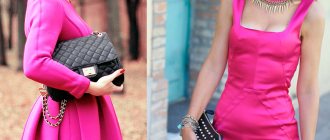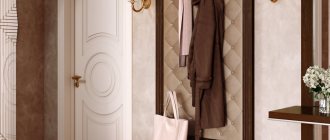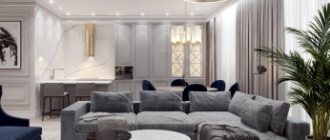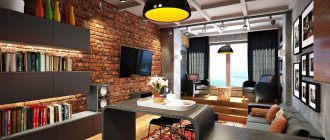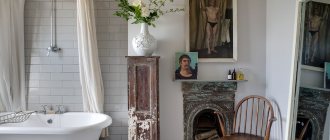History of origin
Nowadays, expensive, exclusive things from the 19th and 20th centuries are called vintage.
The word “vintage” itself came into the general lexicon thanks to winemakers. Back then, this was the name given to wine aged for a long time in a cellar.
The history of the origin of the style is very funny - it happened at the end of the 20th century in the USA. Patrick Willis, as a young architect, decided to present the house in the style of an ellipse.
To complete the composition, he went to a flea market, where he found many unique things that seemed worthy of attention.
It is said that Patrick ended up in this market because he did not have the money to complete the project.
Willis cleaned and restored the purchased items and contributed them to the overall project, which critics approved, noting the ambition and novelty of the young designer's idea.
Since then, the vintage style has appeared in the interior.
Fashion and vintage
In modern fashion, trends that turn us to the past in history and art are increasingly gaining strength. The “vintage” style in fashion as a trend is associated with the use in the creation of modern clothing models of stylistic elements, details, materials, even technology that were used in the creation of clothing models in past centuries for different segments of the population. Moreover, a clear time period is defined: from 1914 to the 1990s.
We can conditionally divide the “vintage” fashion into several directions according to their characteristic features.
Firstly, the fashion style of the 20s: furs, hats with veils, closed collars on blouses, shiny dresses with fringes. Materials for this direction: silk, satin, velvet, soft, plastic, flowing, emphasizing the flexibility and seductiveness of shapes. Type, prototype: Marlene Dietrich.
Secondly, the fashion of the 40s: jackets and dresses with shoulders and an accentuated waist, flared dresses with a mid-calf length, small hats (sometimes with fascinators). The lines are simple and geometric. The rigor and conciseness of the image. Reminds me of a military cut.
Prototype: military uniform.
Thirdly, fashionable in the 50s: bodices (often strapless), corsets, stiletto heels. The look is completed with bright red lipstick. The main idea is the idea of freedom, looseness, and brightness of personality.
Fourthly, the fashion of the 60s, creating diverse and bright images reminiscent of dudes: bright colors, stable heels, simple cut of dresses: flared and a-line, club jackets-blazers are used. The style of minimalism and conciseness.
Prototype: dudes.
Fifthly, the style of the 70s: flared and loose-fitting trousers and jeans, shirts, stable shoes with high wedges, etc. Fashion that is akin to eclectic style. Fashion for freedom of expression and self-awareness, freedom of the individual from society.
Prototype: hippie.
Styles cannot be mixed: all things in the image, hairstyle, makeup and accessories must belong to the same historical era. What makes an image complete is the internal component, when the person who tried on the image is imbued with the aroma and feeling of the era and becomes in harmony with it. At the same time, a new, fresh spirit brought into the image is welcomed.
Basic ideas and features of style
Vintage style involves placing parts and objects in the home that have gone out of fashion (usually using parts from the 19th and 20th centuries).
In some cases, designers intentionally age interior items. Varnishes, applications, sanding materials, sponges and paints help with this.
Key ideas of vintage style in the interior:
- Vintage home interior is the ability to combine modern ideas with antique objects, and they do it easily and unobtrusively.
- Vintage is similar to classic, but is characterized by the use of modern finishing materials and designs disguised as the style of the last century.
- Typically, items that belong to a specific historical era are selected.
- The minimalist style is not combined with vintage. All antique items are put on public display, demonstrating the chosen era.
- At the same time, an abundance of antiques is not welcome. In this case, the vintage style will lose its expressiveness, and the room will become too cluttered.
- When choosing accessories, you should understand that they should be antique or aged, but in no case dilapidated, which are about to crumble.
Accessories
Very often, it is accessories that indicate vintage style. Choose a small flirty hat, glasses with round wide frames, and gloves made of thin leather. Lovers of antiques should have in their wardrobe special shoe models suitable for exclusive clothing.
Vintage shoes with small, stable heels and a rounded toe are the brightest representatives of the era of the 20-50s of the last century. A fashionista's wardrobe must have a pair of rare shoes in a men's style - oxfords, loafers, brogues.
1) Bags
Elegant small handbags or luxurious voluminous briefcases - all this can be matched to a stylish look:
- handbag - a small handbag with a long strap made of soft leather with embroidery or decoration, suitable for sophisticated dresses and skirts;
- travel bag - a trapezoid-shaped bag with a rigid frame made from artificially aged leather;
- briefcase - a bag with a large lock fits perfectly with a military-style look;
- Chanel handbag is a small bag made of soft thin leather with embroidered diamonds, a signature emblem and a gold chain. Be sure to replenish your wardrobe with a spectacular accessory that will elegantly complement your evening or holiday look.
2) Decorations
Large jewelry made of precious or semi-precious stones, as well as retro jewelry, are the best option for creating a single look in vintage style. They can be worn during the daytime and decorate your evening look.
Decorating rooms in vintage style
When choosing the design and decoration of a room, you should first of all pay attention to its purpose.
Bedroom
A vintage bedroom is often decorated with antique furniture. Beds with a canopy or carved wooden legs are perfect.
The design of the canopy also should not be in a minimalist style - it is better to choose an option with lush decor, overlays and inserts.
But remember: in vintage style, the main thing is to keep it in moderation; the room cannot be overcrowded with stylish items.
A boudoir table and a chest of drawers in the color of dark or light wood will complement the vintage bedroom interior. A mirror with an unusual frame is also added to the room.
A velvet chair and the same curtains, crystal chandeliers, a floor lamp with a lampshade and vases with boxes will fit perfectly.
Living room
A vintage living room is decorated in the style of one era. Therefore, before starting design and renovation, you need to determine the historical period.
The basis of the living room interior is an antique sofa. You can place additional vintage interior items around it: paintings and photographs in vintage frames.
Textiles in the room must necessarily match the style.
Kitchen
For a vintage kitchen interior, it is recommended to choose a wooden set, decorated with carvings.
Objects and kitchen furniture used in past centuries are usually placed along the walls.
BAR & BARMEN from Marchi Group
The floors are covered with wood or tiles and are dark in color. And all other surfaces are light (yellow, peach, light blue and light green are ideal).
Design project by Alison Kandler
The entire vintage-style setting in the kitchen interior should evoke calm and tranquility.
Design project Helen Norman
Bathroom
A vintage bathroom is always something unusual and eye-catching. The main detail of the room is the bath. It is chosen in a classic shape, with soft, rounded edges of a light shade.
Place the bath in the very center of the room. It is worth noting that the area of the room does not matter.
Materials for wall decoration are often aged by abrasions.
The mirror should be framed in a wooden frame, the shelves should be made of the same material.
Hallway
A vintage hallway can be decorated with a small chest of drawers and a nightstand. It is advisable to decorate them with abrasions on the edges. A pouf of classic shape and color will complement the interior.
Instead of a dressing room, place a hanger with forged elements.
You can add some zest with the help of an antique chest of drawers and a mirror (it’s great if even the mirror has small echoes of antiquity - scratches or abrasions).
Vintage and art
In this case, vintage is works of decorative and applied art made in the style of the historical periods indicated above, or created in those times and miraculously preserved. A special place in the decorative and applied arts is given to vintage dolls, which have recently become a common collectible. They are also used for interior decoration.
Various materials are used to make vintage dolls: wood, fabric, porcelain, metal, plastic, celluloid, etc. These dolls have a special “humanity,” childlike naivety and sincerity. Other vintage toys are no less interesting.
Nowadays, quite a lot of exhibitions are devoted to the history of toys and dolls, where you can see what they looked like during different periods of development of the toy industry in different countries. And from their authentic costumes you can learn the peculiarities of fashion history.
Particular attention is drawn to antique clocks, tabletop ink sets and calendars, fireplace figurines, painted dishes and samovars, as well as items in the style of folk crafts: birch bark and bast weaving, wood and stone carving, embroidery and lace making, etc.
How to distinguish vintage from junk? A vintage item is rare, unique, unusual, attracting attention with some zest, and not just an old item created in the 20th century.
Vintage interior color
Vintage belongs to the romantic style, so the shades should be chosen in the appropriate direction.
The best option would be pastel, muted colors. Beige, yellow, peach, light pink, blue and soft green shades look great.
The main color can be white, but it is recommended to choose it only if the furniture will be shaded from the surfaces. If the furniture is white, it is better to choose warm colors (pink, green or blue).
To achieve complete style consistency, you need to make the colors appear faded.
Vintage style does not use exclusively light shades. It is quite possible to add bright accents to the room.
Brown, purple, blue and dark green are suitable colors for this style. Green and brown colors are preferable to use in the design of textile parts.
But at the same time, tablecloths, napkins and bedspreads are chosen in white or milky colors.
A vintage-style interior involves the use of prints with flowers, patterns, as well as images of plants and trees. All this adds calm and atmosphere to the room.
Textiles and wallpaper in Chinese or Japanese style will fit perfectly into the overall look of the room. Don't forget about a pop of color in every room.
But keep in mind that it must be one thing: either surface design or furniture.
Wall decoration
When planning your interior, first of all you need to choose what will be in the center of your composition: the color scheme of the room or the furniture. If you choose bright wallpaper, then you should give preference to modest, neat furniture, and large, spectacular things will look much more interesting against the background of pale walls.
Related article: Basic principles of shabby chic style: design nuances
As for colors, vintage style rooms most often use wallpaper with various floral or floral patterns.
As a rule, there are three options for wall design:
- A contrasting option reminiscent of Art Nouveau design. Often one wall is designed in one color scheme, and the adjacent one is decorated with striped wallpaper or wallpaper with a large ornament or pattern.
- Japanese or oriental motifs: rich primary color of wallpaper with images of sakura, flowers, birds, intertwined branches.
- A classic option: neutral pastel wallpaper with a small repeating pattern. As a rule, the entire room is covered, but now, under the influence of fashion trends, only a few strips of patterned wallpaper are increasingly being used in addition to a plain wall color scheme.
.
Apartment interior design in vintage style
Vintage style is largely individual, so there are no specific strict rules for its use.
But there are still a number of recommendations that will help create a truly stylish room:
- A combination of the incongruous. This principle is used in many styles, and vintage is no exception. A plasma TV on an aged cabinet or a laptop on a worn-out chest of drawers is a great combination.
- Don't buy unnecessary items. Many people think that to create a room in a vintage style, it is only important to pile it up with a lot of antique things. Don't go overboard with buying antiques. The room should contain only the essentials.
- Familiarize yourself with the selected historical period. To make a vintage room look stylish and tasteful, imagination alone is not enough. You need knowledge about the era. We recommend watching a thematic movie, leafing through magazines, or reading the memoirs of a figure of a certain era.
- Don't forget about modernity. It is important to remember that vintage style only adjusts the room, and does not completely change it. Therefore, it is not recommended to decorate the room only in vintage style. Let it be modern or classic with elements of aging.
- Furniture and items should be renovated. To create a complete image, it is necessary to carry out appropriate repairs - add abrasions, patinas, and scratches to the walls and floors.
- Use wood, forging and ceramics. Elements made from these materials are time-tested and will definitely remind you of antiquity.
- No artificial elements.
History of style
Incredibly emotional, elegant and intellectual, vintage style remains in demand and popular in both fashion and interior design. How did the idea of using antique products in modern life come about?
The concept of “vintage” was originally used by French winemakers to designate elite varieties of wine with a long shelf life. A little later, this name began to be given to any items of value and exclusivity. That's why vintage style evokes associations with luxury, antiquity and originality.
True connoisseurs of things in retro style divide all antique products depending on the era from which they have survived to this day:
1) 20th
The era of freedom and a complete change in the image of all women. The beauties of those years actively cut their hair, while simultaneously shortening the length of their dresses. Simple knee-length dresses and skirts made of satin, silk, and velvet revealed charming women's legs and shoes.
2) 30's
Time for glamor and glitter. All clothes emphasized the female form - special emphasis was placed on the neckline and waist. It was considered a special chic to decorate your image with expensive furs and jewelry. For evening outings, outfits were made from expensive materials, and no expense was spared for decoration - bright fittings, accessories made of leather, varnish, velvet, and fur were used.
3) 40s
A difficult time in human history, which undoubtedly affected fashion. Women preferred to have practical, comfortable things in their wardrobe that vaguely resembled military uniforms. Fashion designers stopped sewing products with complex cuts, and decor completely disappeared from the line of women's clothing. Women wore men's clothing in dark colors, caring, first of all, about comfort, and not about their beauty.
4) 50s
It's time when femininity comes back into fashion! The most popular are full skirts, combined with a top that fits the silhouette. Or the reverse set - a jacket with wide shoulders was worn under a narrow pencil skirt. Accessories are becoming increasingly important in a woman’s look: small hats, handbags, beads and brooches.
5) 60s
A radical change in the image of a woman - short boy haircuts are popular again. For the first time, a frank and scandalous miniskirt, exposing the legs above the knee, comes into fashion. Unusual shoes also appeared in the 60s. Platform shoes, stiletto heel boots, ankle boots with wide tops - all this was worn by our mothers and grandmothers in the middle of the last century.
6) 70s
For a casual look, we chose flared trousers that looked great with checkered shirts, tunics and jumpers with ethnic patterns. The appearance of blue jeans in a vintage style and sneakers became an attribute of success and accompanied both women's and men's looks. The hippie style spread across many countries and continents, and the spirit of freedom and rebellion was reflected in fashion as well.
7) 80s
The era of sports and classics. Classic-style items were used as everyday clothing - strict shades, jackets and straight-cut skirts. A top or blouse in linen style could be an elegant element in a business look. For relaxation and meeting with friends, fashionistas and fashionistas chose sports-style clothes. Jeans and sneakers also remained trendy, captivating consumers with their comfort and convenience.
Materials and finishing
The main point when choosing materials for surface finishing is the preference for natural ones; artificial ones should be abandoned.
Copper, natural stone, ceramics, bronze and wood are ideal.
Parquet or tiles are suitable for the floor. You should avoid tiles, glossy laminate and linoleum.
Stretch ceilings and heavy hanging structures are not used in the interior.
The vintage style ceiling has only a few scuffs or uneven spots.
Vintage walls are decorated with wallpaper with flowers or birds and trees. An option is available with wallpaper painted in one shade, as well as the use of brick.
Designers recommend combining similar shades of colors.
Vintage furniture
Don't forget that all vintage style furniture must be from the same historical period.
Scuffs, cracks and light, neat scratches will add style. At the same time, the furniture should not fall apart; its task is to cause aesthetic pleasure.
Vintage attributes in the room: a chest of drawers, a trellis, a sideboard, a carved chest, a buffet or cupboard, a wardrobe with aged legs, and a rocking chair.
When arranging furniture, it is important to observe the principle of symmetry. All items are placed in pairs.
Vintage textiles
Vintage-style decor is impossible to imagine without textile additions.
These include blankets thrown over the back of rocking chairs, bedspreads on beds and sofas, as well as hand-embroidered napkins and tablecloths.
All fabrics must be natural. Choose from cotton, linen, jacquard, satin, wool and silk.
The prints and patterns chosen are approximately the same as for wall decoration. Do not forget about the important role of curtains and pillows. They create the atmosphere of the room.
When choosing textiles, it is important not to overdo it.
What materials to prefer
In general, the finishing of the main surfaces determined the use of natural wood, paper or textile wallpaper, and paint. But these are not all the materials used in vintage style. In addition to the above and ceramic tiles, interior items, as well as decoration, can be created using forged parts, copper and bronze elements, natural stone, and precious metals.
Furniture
Despite the fact that furniture should be visually worn out, its shape, materials, and decor can be vintage. It doesn't have to be peeling paint or scuffed surfaces. This is necessary for simple rustic rooms, but in luxurious interiors it is better to abandon such “aging”.
Almost every room made in vintage style has an original shape and finish of a chest of drawers or chest, bureau, sideboard or dressing table. It is precisely such items that most often retain a touch of antiquity, because they are simply absent from modern catalogs of furniture factories.
A leather sofa or chair with curved legs would be harmonious. But this is not that soft corner that testifies to the wealth of its owners, but wooden furniture, only part of which is upholstered in leather.
Most often, antique objects have round shapes. It's not just the curved legs, but the entire body. For example, a chest of drawers or a chest may appear “inflated” due to the bent shape of the frame walls. At the same time, wooden objects almost always have carved and applied decorative details. All lower parts of the furniture are also decorated with graceful cutouts. Usually they go symmetrically from the middle to the corners. Such decor can be seen both in wooden products and in the decoration of bathtubs, in stone masterpieces of the past, in the frames of mirrors and paintings.
Wooden furniture is usually varnished or painted. In vintage style they rarely remain simply polished. Moreover, craquelure would be appropriate here - a mesh of cracked paint through which another layer is visible. Decoupage on vintage furniture will look beautiful.
You can make one yourself. Turning an ordinary old table into an antique one is also quite simple: just lay ceramic tiles, broken into irregular pieces, directly onto the tabletop. It will look like a cracked ceramic surface. All this can be covered with twine or trimmed around the perimeter with lace. You can do the same with a number of decorative details.
Decor
The decor is primarily furniture with its curved shapes, overlays, and carvings. But, of course, other details will be mandatory in a vintage-style interior:
- Crockery is often used here as decoration. It is displayed in cupboards, on open shelves. The plates can be decorated with decoupage or painted. The dishes can also be antique - thin and elegant, or, on the contrary, rather rough ceramic.
- Vases, figurines, table and grandfather clocks, paintings - a standard set of quite familiar things can look in the spirit of antiquity. These elements can also be worn, aged, or painted using the craquelure technique.
- Fresh and dried flowers will always be appropriate in any vintage-style room, even in the bathroom.
- Textiles are necessarily used in every room. These are not only curtains of traditional shape. Here you need napkins, tablecloths, curtains on furniture, lace instead of glass in the buffet - you can find a lot of options for using handicrafts or purchased fabrics.
- If possible, decorate the room with a fireplace. It is decorated with an exquisite portal, which can be quite massive in a spacious room.
- Candlesticks made of heavy metal, bronze lamps, forged chandeliers are another trend in decorating a vintage interior.
- A samovar, ivory items, an iron, a spinning wheel, etc. will not be out of place.
- Old yellowed photographs of grandmothers and great-grandmothers will decorate the room and create the right atmosphere.
- The curtains here deserve special attention. These can be heavy curtains, as in classicism, or light linen or chintz curtains, as in Provence or country. If we talk about classic models, they should be decorated with lambrequins, tassels, and ruffles. Ruffles can also be used on light natural curtains.
Implementation of style in individual rooms
Vintage style decor
Vintage decor helps complete the decor of the room.
Select the following items:
- Cuckoo-clock;
- samovar;
- chandelier fan;
- black and white photographs;
- reel-to-reel tape recorder or gramophone;
- old sewing machine;
- table sets and tea sets;
- candlesticks;
- cast iron;
- unusual vases or plates hanging on the walls;
- porcelain figurines;
- flowers in vases and pots.
Features of vintage room decor
To complete the stylization, you need to select lamps, textiles and other objects that fill the space in the same style.
Lamps in such a room can be either as simple as possible, having strict geometric shapes, or complex, with numerous details, volumetric compositions:
- chandeliers with shades made of thick glass, an abundance of screws, brackets, and metal parts. They are attached to the ceiling using a strong chain;
- lamps with wooden shades;
- floor lamps with large lampshades;
- handmade designer lamps - made of metal, wood. Their shape can be different: in the form of an old kerosene lamp, a dome-shaped cage.
Important! Both lamps and other decorative items should correspond to the era that you are stylizing.
That is why an antique copper samovar, a cast iron iron, a sewing machine from the Singer factory, as well as a Soviet-era fan chandelier and an abundance of glass and crystal in a lacquered sideboard may be appropriate here.
Vintage style in the interior of the room
Apartment design in vintage style
The following can complement the interior of a living room in a vintage style:
- floor or wall cuckoo clock;
- a mirror in a carved frame - if you find an old one with black spots on the amalgam - it will be perfect;
- black and white photographs on the wall or on a closet shelf;
- carpet on the floor (the same as they used to hang on the walls);
- gramophone or reel-to-reel tape recorder - depending on the period that is embodied in your room.
On the walls of the bedroom and hallway, decorated in the spirit of the 50-60s of the last century, posters, posters, theater posters of that time can be placed, there is also a place for a forged or wooden shelf, dressing table. Place a floor lamp on a high leg with a fabric lampshade next to the bed.
Creating a vintage interior in a modern apartment is exciting and interesting. Decoration will not take much time and will not require significant expenses, but you and your friends and family will have the opportunity to plunge into past eras and take a break from the reactive rhythm of modern life.
See alsoShabby chic style interior: features, photos
Lighting
Lighting fixtures in a vintage room should be expensive and luxurious.
Chandeliers with crystal elements, sconces and floor lamps (wonderful if they have fabric lampshades and fringe), and bronze lamps are suitable.
Modern lighting devices are not used in room decoration. The lighting itself should be warm and soft, avoid harsh and contrasting light.
Difference from other styles
The main distinguishing feature of vintage style is the combination of antiquity and modernity. Also for vintage it is important to restore furniture that has gone out of fashion and use it in a modern way.
To create a vintage interior design, they also use interior items that were at the peak of popularity in a certain era.
The main distinguishing condition is to choose antique items or give new things an aged effect. It is necessary to abandon modern finishing options.


